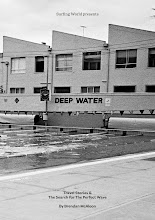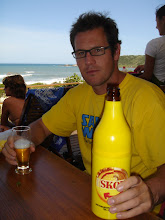
Jon Frank would be considered a successful surf photographer. For the past two decades he’s made a living from expressing his unique vision of surfing and ocean waves, which is quite a feat in itself. He filmed the seminal surf film Litmus in 1995, and a slew of award-winning surf films followed, including Super Computer in 2001, Mick Fanning’s acclaimed biopic Mick, Myself & Eugene, and more recently Musica Surfica. But the still image is Frank’s preferred medium and where he is held in highest regard; he won Photo of the Year at the 2007 Surfer Poll and Video Awards and the 2008 Australian Surfing Awards, and is widely regarded as the artist of the surf image. “What Jon Frank does is ART,” according to grizzled Hawaiian surf photographer Sean Davey.

Despite Divine’s assessment, I am not implying that Jon Frank is “tweaked”. In fact, Frank is one of my closest friends and I admire him far beyond his ability to capture ethereal ocean images. But, as Derek Hynd explained in the introduction to Frank’s 1999 book Waves Of The Sea: “He is not normal. His work is not normal.” A perfect example is his ongoing Frankology series for Surfing World magazine, which is without peer and demonstrates his virtuosity – most are shot over a few days and are brilliant snapshots of people and places, accompanied by Frank’s vivid musings about everything from memories of his much-loved father to riding the tattered sea, “daydreams and life plans hatched under the murky light thrown by a single round porthole”. It doesn’t always make sense and sometimes feels like an unedited invasion into his inner most thoughts, but it is Frank, and brilliant nonetheless.
Frank joined me on many of my expeditions for Deep Water, initially as a hired gun for Rip Curl, and later when his path crossed with the pro surfing circus and he needed a couch to crash on or a hotel room to shower and shave. He appears intermittently throughout the book, and his incredible images of Hawaii’s outer reefs and Icelandic beaches gave the book an esoteric layer that lifted it beyond my imagination. Frank also provided comic relief:
“The boat was island-hopping from Biak to West Papua, searching unsuccessfully for surf. We drifted in the lee of an uncharted bay, a large sea eagle circling overhead. I lay on the top bunk reading, peering out the dirty porthole to check the waves. Again. Waist-high chunks of windswell sloped onto an exposed limestone reef. The jungle swayed. A dead tree stood proudly on the edge of a slender strip of sand. My head went back to the pillow, fumbling to find my page, tempted by my hidden stash of Beng Beng chocolate bars. Frank woke up. He declared: “I’m going on the ‘net when I go home. I’m going on the ‘net to meet a woman”. He slammed the door and stamped down the passage, his footsteps echoing around the wooden hull. I heard the lock on the toilet click.” – Chapter 7, The Curse of the Indo Jiwa
 But Frank is more than comic relief. He's more like something closer to Kerouac’s Dean Moriaty in On The Road, albeit without the wild exuberance and swashbuckling good looks. And, despite recent forays into the fine art world, documenting classical musical festivals in Slovenia, Frank is still on the road. Right now he is in Hawaii. He sent me an email a few days ago. I could instantly picture him, in his small room tucked in behind the garage of a sprawling Ke Nui Road mansion, bent over the keyboard, Sufjan Stevens crooning in the background, wet footprints and sand at his feet. Right outside the door is his office – the stretch of sand between Log Cabins and Pipeline, where the world’s best surfers spend each December performing on cue for the cameras. Frank will be among them, rubbing shoulders with Davey, Grambeau, Buckley & co. It sounds glamorous. It isn’t. “It’s hard to be 38 years old, having been a professional surf photographer for 15 years, looking down the barrel of 40, wondering whether I can keep doing it,” Frank told me recently. He doesn’t want to sound bitter. He isn’t. “I’m not saying it’s not a great job. I’m used to the insecurity. I’m pretty used to not having any money. The travel becomes more difficult when you have a family but I understand that people would dream of doing it instead of working in an office or a factory.”
But Frank is more than comic relief. He's more like something closer to Kerouac’s Dean Moriaty in On The Road, albeit without the wild exuberance and swashbuckling good looks. And, despite recent forays into the fine art world, documenting classical musical festivals in Slovenia, Frank is still on the road. Right now he is in Hawaii. He sent me an email a few days ago. I could instantly picture him, in his small room tucked in behind the garage of a sprawling Ke Nui Road mansion, bent over the keyboard, Sufjan Stevens crooning in the background, wet footprints and sand at his feet. Right outside the door is his office – the stretch of sand between Log Cabins and Pipeline, where the world’s best surfers spend each December performing on cue for the cameras. Frank will be among them, rubbing shoulders with Davey, Grambeau, Buckley & co. It sounds glamorous. It isn’t. “It’s hard to be 38 years old, having been a professional surf photographer for 15 years, looking down the barrel of 40, wondering whether I can keep doing it,” Frank told me recently. He doesn’t want to sound bitter. He isn’t. “I’m not saying it’s not a great job. I’m used to the insecurity. I’m pretty used to not having any money. The travel becomes more difficult when you have a family but I understand that people would dream of doing it instead of working in an office or a factory.”
I know exactly what he means. I’m back in an office, grinding out the 9 to 5. And while there are elements I really enjoy, I have my moments, dreaming of that boat drifting in the lee of an uncharted bay somewhere east of Sulawesi. I’m no longer Sal Paradise to Frank’s Dean Moriaty. I’m busy conjuring up domestic bliss on a curve of the Great Ocean Road, staring at a sink full of baby bowls and brightly coloured utensils. As Frank once wrote: “Standing, shoulders down, enjoying warm hands, stopping occasionally to watch the moonlit trees bend behind the west wind, all of us together but alone, beneath this vast Bill Henson sky.” Or in my case, an underexposed Jon Frank panorama.















